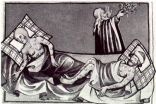(Press-News.org) MADISON, Wis. — No matter how many times it's demonstrated, it's still hard to envision bacteria as social, communicating creatures.
But by using a signaling system called "quorum sensing," these single-celled organisms radically alter their behavior to suit their population. In short, some bacteria "know" how many of them are present, and act accordingly.
Once the population of quorum-sensing bacteria reaches the millions, it may change from innocuous to pathogenic, or from unhelpful to helpful. The quorum-sensing messages are carried in small molecules that the bacteria release and whose concentration bacteria can measure.
Blocking such a signal can prevent a bacterium from turning, in common language, nasty.
Helen Blackwell, a professor of chemistry at the University of Wisconsin-Madison, has been making artificial compounds that mimic the natural quorum-sensing signals, including some that block a natural signal from binding to its protein target.
In research published today in the journal Chemistry & Biology, Blackwell changed key building blocks in these protein targets one by one. "If that part of the protein is important, the change will have a significant effect on our signal's activity," she explains.
In the study performed with recent graduate students Joseph Gerdt and Christine McInnis, Blackwell expected to knock out, or deactivate, the signals by making these point modifications. Sometimes, however, the changes actually converted an activation signal into a deactivation signal, or vice versa.
"It was surprising that making minor tweaks, very subtle changes, to the protein would convert a compound from an inhibitor to an activator, or turn an activator into an inhibitor," she says. "That shows that small-molecule control of quorum sensing is very finely tuned, much more than we even expected."
Quorum sensing is present in many, but not all, bacteria, and its advantage is clear. A few hundred bacteria cannot hope to overwhelm an animal host, so lying low and evading immune attack is a good survival tactic. But once they number in the millions, they can overwhelm the immune system and reproduce unscathed.
After quorum sensing delivers the attack signal, a group of bacteria can become more infective and start to secrete small, poisonous molecules or tissue-destroying enzymes. They may also form biofilms, a tough film that covers surfaces and protects bacteria members from harm.
Quorum sensing can also direct soil bacteria that infect soybean roots to harvest nitrogen from the atmosphere and improve crop yields.
Blackwell, who has studied quorum sensing for more than 10 years, explains that inhibiting quorum sensing may provide a new way to control pathogenic bacteria. "We are approaching the end of the antibiotic era, as bacteria evolve resistance to some of our most advanced drugs, and scientists are looking for alternative ways to control bacteria."
While current antibiotics are designed to kill microbes, the goal of quorum sensing would be to keep them "tame" and harmless, Blackwell says. "If these 'on/off' protein modifications are as important as we have found, they may help us design new compounds to inhibit quorum sensing and reduce the harm of bacterial infections, without causing the drug resistance that is producing so many problems today."
Reducing infectivity may allow the immune system to help clear the pathogen, Blackwell says. In procedures such as hip replacement or burn treatment, where infection is common, "this could be used prophylactically, or to augment and extend the lifetime of antibiotics."
The study was performed on Gram-negative bacteria, which are well protected from many drugs by a double membrane. "They also have lots of nasty pumps that eject those drugs that do enter," Blackwell says.
Gram negatives include E. coli, salmonella, shigella, and pseudomonas. Members of the group cause cholera, gonorrhea, meningitis, Legionnaire's disease, and respiratory and gastrointestinal diseases.
Gram negatives "are probably the most challenging infections, and the drugs that we have are really failing," Blackwell says. "But there is also a fascination in seeing how these very simple organisms team up to do things that are impossible in small numbers.
"The compounds and protein modifications we identified in the current study will serve as useful research tools to elucidate, and perhaps redirect, their 'tiny teamwork.'"
INFORMATION:
David Tenenbaum
608-265-8549
djtenenb@wisc.edu
Researchers study vital 'on/off switches' that control when bacteria turn deadly
2014-09-18
ELSE PRESS RELEASES FROM THIS DATE:
Researchers develop unique waste cleanup for rural areas
2014-09-18
PULLMAN, Wash. - Washington State University researchers have developed a unique method to use microbes buried in pond sediment to power waste cleanup in rural areas.
The first microbe-powered, self-sustaining wastewater treatment system could lead to an inexpensive and quick way to clean up waste from large farming operations and rural sewage treatment plants while reducing pollution.
Professor Haluk Beyenal and graduate student Timothy Ewing in the Voiland College of Engineering and Architecture discuss the system in the online edition of Journal of Power Sources ...
Video games could dramatically streamline educational research
2014-09-18
PULLMAN, Wash. – "Seeking educational curriculum researchers. Humans need not apply."
A Washington State University professor has figured out a dramatically easier and more cost-effective way to do research on science curriculum in the classroom – and it could include playing video games.
Called "computational modeling," it involves a computer "learning" student behavior and then "thinking" as students would. Rich Lamb, who teaches science education at WSU's College of Education, said the process could revolutionize the way educational research is done.
Lamb's research ...
Tree rings and arroyos
2014-09-18
Boulder, Colo., USA – A new GSA Bulletin study uses tree rings to document arroyo evolution along the lower Rio Puerco and Chaco Wash in northern New Mexico, USA. By determining burial dates in tree rings from salt cedar and willow, investigators were able to precisely date arroyo sedimentary beds 30 cm thick or greater. They then combined this data with aerial imagery, LiDAR, longitudinal profiles, and repeat surveys to reconstruct the history of these arroyos.
Arroyos are deep, oversized channels that have vertical or steeply cut walls made up of silt, clay, or sand. ...
Spouse's personality influences career success, study finds
2014-09-18
As people spend more and more time in the workplace, it's natural for co-workers to develop close bonds — what's often referred to as a "workplace spouse" or an "office wife."
But when it comes to pay raises, promotions and other measures of career success, it's the husband or wife at home who may be exerting a bigger influence on workplace performance, suggests new research from Washington University in St. Louis. "Our study shows that it is not only your own personality that influences the experiences that lead to greater occupational success, but that your spouse's ...
Marcellus drilling boom may have led to too many hotel rooms
2014-09-18
Drilling in Pennsylvania's Marcellus Shale region led to a rapid increase in both the number of hotels and hotel industry jobs, but Penn State researchers report that the faltering occupancy rate may signal that there are now too many hotel rooms.
"Demand is still high in many of the counties in the Marcellus Shale region, but the occupancy rate is starting to come down," said Daniel Mount, an associate professor in hospitality management. "The case could be made that this is a sign that hotels were overbuilt."
Marcellus drilling operations generated approximately $685 ...
Survey: Fortune 500 employees can expect to pay more for health insurance
2014-09-18
Employees working for Fortune 500 companies can expect to pay higher employee contributions for their health insurance, according to a survey of chief human resource officers about the impact of the Patient Protection and Affordable Care Act (also known as PPACA or Obamacare) conducted by the Darla Moore School of Business at the University of South Carolina this past May/June.
Patrick Wright, a professor in strategic human resource management, directs the annual the HR@Moore Survey of Chief HR Officers. The survey is distributed to more than 560 CHROs of Fortune 500 ...
Agricultural fires in the Ukraine
2014-09-18
Numerous fires (marked with red dots) are burning in Eastern Europe, likely as a result of regional agricultural practices. The body of water at the lower left of this true-color Moderate Resolution Imaging Spectroradiometer (MODIS) image is the Sea of Azov. The Sea is bordered by Ukraine to the northwest, west and southwest and by Russia to the northeast, east, and southeast. To its left is the Black Sea.
The location, widespread nature, and number of fires suggest that these fires were deliberately set to manage land. Farmers often use fire to return nutrients to the ...
Professional recommendations against routine prostate cancer screening have little effect
2014-09-18
DETROIT – The effect of guidelines recommending that elderly men should not be routinely screened for prostate cancer "has been minimal at best," according to a new study led by researchers at Henry Ford Hospital.
The study, published as a research letter online in JAMA Internal Medicine, focused on the use of PSA – prostate-specific antigen – to test for prostate cancer.
"We found that the effect of the guidelines recommending against the routine screening of elderly men in particular has been minimal at best," says Jesse Sammon, D.O., a researcher at Henry Ford's Vattikuti ...
New insights on an ancient plague could improve treatments for infections
2014-09-18
DURHAM, N.C. – Dangerous new pathogens such as the Ebola virus invoke scary scenarios of deadly epidemics, but even ancient scourges such as the bubonic plague are still providing researchers with new insights on how the body responds to infections.
In a study published online Sept. 18, 2014, in the journal Immunity, researchers at Duke Medicine and Duke-NUS Graduate Medical School Singapore detail how the Yersinia pestis bacteria that cause bubonic plague hitchhike on immune cells in the lymph nodes and eventually ride into the lungs and the blood stream, where the infection ...
Sensing neuronal activity with light
2014-09-18
For years, neuroscientists have been trying to develop tools that would allow them to clearly view the brain's circuitry in action—from the first moment a neuron fires to the resulting behavior in a whole organism. To get this complete picture, neuroscientists are working to develop a range of new tools to study the brain. Researchers at Caltech have developed one such tool that provides a new way of mapping neural networks in a living organism.
The work—a collaboration between Viviana Gradinaru (BS '05), assistant professor of biology and biological engineering, and ...






